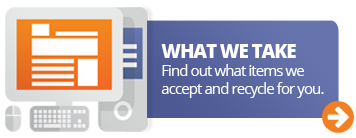Wearable, pluggable, and fashionable.
Just like fast fashion and fast food, electronics involve a rapid turnover in style trends, with revenues dependent on selling the latest products.
Our growing relationship with electronic devices has increased as product affordability has opened up opportunities leading to greater sales and take up rates.
Eventually, all these electronic gadgets or appliances will become e-waste.
In 2017, one report put the global consumer electronics market at around $US1.1 trillion, growing at a rate of 6% until 2024, when it will be worth $US1.7 trillion.
So, from a legislative perspective, what are we doing?

Globally, a total of 67 countries have legislation in place to deal with the e-waste they generate.
This legislation normally takes the form of Extended Producer Responsibility, when a small charge on new electronic devices subsidises end-of-life collection and recycling. The legislation covers about two-thirds of the global population.
However, many countries do not have national legislation on e-waste. In many regions of Africa, Latin America or South-East Asia, electronic waste is not always high on the political agenda.
When it comes to the export of e-waste to developing countries, it is regulated under the Basel Convention, which has been ratified by 188 countries.
Even with the convention in place, large amounts of e-waste continue to be shipped illegally.
FACT: 1.46 billion smartphones were sold in 2017. [1]
It is estimated that if the raw materials of these phones
were recycled, they could be worth up to $11.5 billion. [2]
Where do we go from here?
No chaos, no disruption. Not to mention no silver bullet.
The approach needs to be careful and considered, staged and well executed, providing a holistic solution to a problem affecting everyone.
We talk about it all the time – the circular economy. It can be achieved through different business models including product as a service, sharing of assets, life extension and finally recycling. To build a circular economy for electronics, consider the following building blocks as vital:
-
Product Stewardship is key
Australia’s approach to managing the growing issue of e-waste is founded on the notion of product stewardship.
This approach acknowledges that those involved in producing, selling and using products have a shared responsibility. This way we work to ensure that products or materials are managed in a way that reduces their impact, throughout their life cycle, on the environment and on human health and safety.
A key pillar of Australia’s National Waste Policy is the Product Stewardship Act 2011. Established under the Act, the National Television and Computer Recycling Scheme (NTCRS) was Australia’s first producer responsibility arrangement.
Under the Scheme more than 150,000 tonnes of e-waste has been managed by ANZRP’s flagship program TechCollect.
-
Design
Products need to be better designed allowing easier reuse, durability and safe recycling.
Many companies have made global commitments to designing waste out of the electronics value chain, whilst others have worked hard to design hazardous materials out of their products.
Embracing durable designs will ensure that electronic devices are kept in circulation for longer. Configurations should have a product’s end-of-life in mind, as well as encouraging disassembly and reuse.
-
Buy-back or return systems
Increasingly, producers of electronics could offer buy-back or return systems for old equipment, incentivising the consumer financially and guaranteeing their data will be properly handled.
-
Advanced recycling and recapturing
Companies and governments can work towards creating a system for closed-loop production in which all old products are collected and reintegrated into new ones.
In China for example, there is a target for 20% recycled content in all new products by 2025.
-
Durability and repair
Post-consumer recycling of electrical and electronic goods is simply not enough. We must be able to benefit from well designed, long-lasting products.
Companies should be ready to repair or refurbish equipment they sell, something that has been mandated by ‘right to repair’ laws in some jurisdictions.
-
Urban mining
No need to go below ground with such an abundance of resources surrounding us. As an emerging industry, companies now are investing in a range of new technologies that extract metals and minerals from e-waste. Already one recycler in China produces more cobalt than the country mines in one year.
-
Reverse logistics
When a product can no longer be used, the materials are collected and sent back to be reintegrated into production.
Unlike a forward supply chain, the movement and processing of materials are not subsidised by the value of a finished product.
Instead manufacturers must rely on the value of the raw materials only and therefore require a highly efficient reverse supply chain to get this model to work.
Inevitably, innovation is unstoppable. Technology is ever evolving, and consumer demand is insatiable.
Pressure on resources and landfill will continue to mount. Almost everyone reading this article and discussing this problem will find a need to update some form of electrical gadget in the coming 24 months – further adding to the problem.
The time to act is now. We have the means, the vision, the supporting infrastructure and the compelling data to transition towards a circular economy. With the world’s recycling markets shutting their doors, ‘now’ never sounded so urgent.
[1] Moore Mike, Smartphone sales see significant drop in 2017, Tech Radar, 28 February 2018, www.techradar.com/news/smartphone-sales-see-significant-drop-in-2017
[2] Baldé, C. P., et al., The Global E-waste Monitor 2017, UNU, ITU, ISWA, 2017 – www.itu.int/en/ITU-D/Climate-Change/Pages/Global-E-waste-Monitor-2017.aspx










